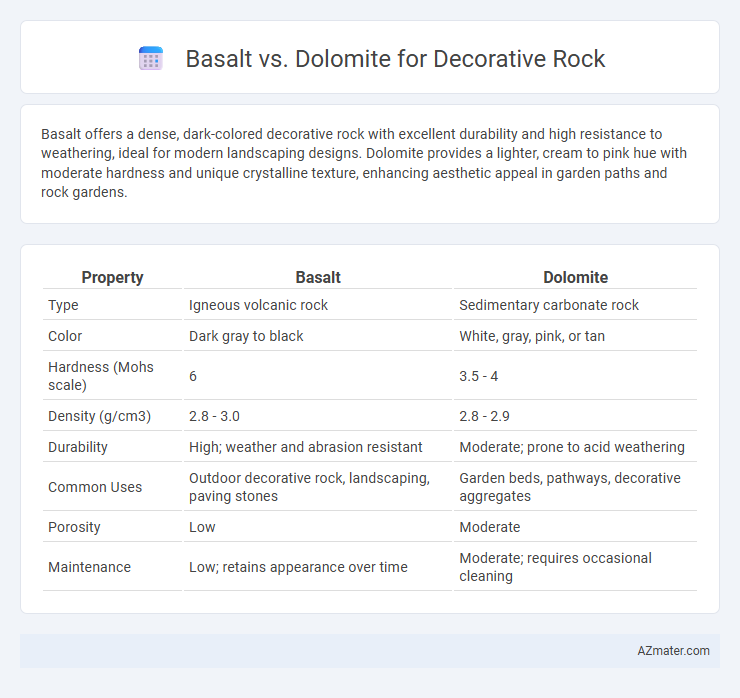Basalt offers a dense, dark-colored decorative rock with excellent durability and high resistance to weathering, ideal for modern landscaping designs. Dolomite provides a lighter, cream to pink hue with moderate hardness and unique crystalline texture, enhancing aesthetic appeal in garden paths and rock gardens.
Table of Comparison
| Property | Basalt | Dolomite |
|---|---|---|
| Type | Igneous volcanic rock | Sedimentary carbonate rock |
| Color | Dark gray to black | White, gray, pink, or tan |
| Hardness (Mohs scale) | 6 | 3.5 - 4 |
| Density (g/cm3) | 2.8 - 3.0 | 2.8 - 2.9 |
| Durability | High; weather and abrasion resistant | Moderate; prone to acid weathering |
| Common Uses | Outdoor decorative rock, landscaping, paving stones | Garden beds, pathways, decorative aggregates |
| Porosity | Low | Moderate |
| Maintenance | Low; retains appearance over time | Moderate; requires occasional cleaning |
Introduction to Basalt and Dolomite
Basalt is a dense, igneous volcanic rock known for its dark color and durability, making it a popular choice for decorative rock applications requiring long-lasting materials. Dolomite, a sedimentary carbonate rock composed primarily of calcium magnesium carbonate, offers a lighter color palette and a unique crystalline texture ideal for landscaping and decorative uses. Both rocks provide distinct aesthetic and physical properties, allowing selection based on specific design and functional requirements.
Geological Origins and Composition
Basalt is an igneous rock formed from rapidly cooled lava, composed primarily of plagioclase and pyroxene minerals, giving it a dense, fine-grained texture ideal for durable decorative rock applications. Dolomite is a sedimentary carbonate rock composed mainly of the mineral dolomite (calcium magnesium carbonate), known for its slightly softer texture and often used in landscaping for its natural, muted colors. The contrasting geological origins--volcanic for basalt and sedimentary for dolomite--affect their hardness, weathering properties, and aesthetic qualities in decorative uses.
Color and Aesthetic Appeal
Basalt offers a sleek, dark gray to black color palette with a fine-grained texture that provides a modern, minimalist aesthetic ideal for contemporary landscaping designs. Dolomite features a lighter color range, including cream, white, beige, and soft pink hues, creating a warm and natural appearance favored for rustic or Mediterranean-style gardens. The distinct color contrast between basalt's deep, uniform shade and dolomite's varied, softer tones ensures each rock type complements different decorative rock applications based on desired visual impact.
Texture and Surface Finish
Basalt offers a dense, fine-grained texture with a smooth, often glassy surface finish that enhances its durability and sleek appearance in decorative rock applications. Dolomite features a coarser, crystalline texture with a matte to slightly rough surface finish, providing a natural, rustic look ideal for garden paths and landscaping accents. The choice between basalt and dolomite depends on whether a polished, modern aesthetic or a textured, natural appeal is desired.
Durability and Weather Resistance
Basalt offers superior durability and exceptional weather resistance due to its dense, fine-grained structure, making it ideal for long-lasting decorative rock applications in harsh climates. Dolomite, while aesthetically appealing with its lighter color and crystalline texture, is more prone to weathering and erosion under extreme environmental conditions. The high compressive strength and low porosity of basalt contribute to its ability to resist freeze-thaw cycles and chemical decay better than dolomite.
Ease of Installation and Maintenance
Basalt offers ease of installation due to its dense, angular fragments that interlock well, providing stable ground cover with minimal shifting. Dolomite, being softer and more porous, can be easier to handle but may require additional compaction or edging to prevent displacement over time. Maintenance-wise, basalt resists weathering and staining better than dolomite, reducing the frequency of cleaning and replacement in decorative landscaping applications.
Applications in Landscaping and Garden Design
Basalt and dolomite each serve distinct purposes in landscaping and garden design, with basalt prized for its durability and dark, textured appearance, making it ideal for pathways, retaining walls, and accent features. Dolomite offers a lighter color palette and is valued for soil pH adjustment and drainage improvement, enhancing garden health and plant growth. Both materials provide unique aesthetic and functional benefits, suitable for various design styles and environmental requirements.
Cost Comparison and Budget Considerations
Basalt typically costs between $50 and $100 per ton, making it a more affordable option for decorative rock compared to dolomite, which ranges from $75 to $150 per ton due to its higher processing requirements. Budget considerations should account for the durability and aesthetic preferences, as basalt offers excellent longevity and a dark, uniform appearance, while dolomite provides lighter tones and is valued for its unique texture. Choosing between basalt and dolomite depends on project scale and desired visual impact, with basalt being preferred for cost-effective landscaping solutions.
Environmental Impact and Sustainability
Basalt and dolomite differ significantly in environmental impact and sustainability when used as decorative rock. Basalt's volcanic origin and dense composition result in high durability and low maintenance, reducing the need for frequent replacement and minimizing resource consumption. Dolomite extraction, often involving extensive quarrying, can lead to habitat disruption and higher carbon emissions, while basalt's widespread availability and lower processing energy contribute to a smaller ecological footprint.
Choosing the Right Decorative Rock for Your Project
Basalt offers a dense, dark gray to black appearance with excellent durability and weather resistance, making it ideal for modern landscaping designs requiring a strong, sleek aesthetic. Dolomite features a lighter color range from white to light gray with mineral variations that create subtle texture, suitable for projects seeking a natural, softer visual appeal. Selecting between basalt and dolomite depends on the desired color scheme, texture, and environmental durability required for your decorative rock application.

Infographic: Basalt vs Dolomite for Decorative Rock
 azmater.com
azmater.com